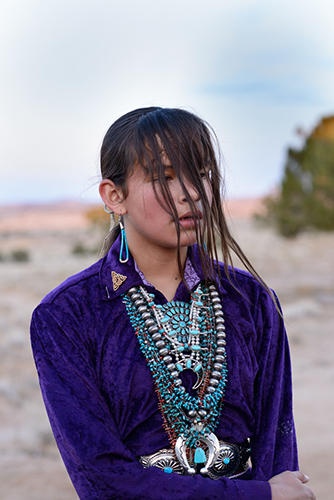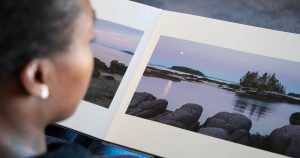
Editor’s note: Funding & Publishing Personal Projects is an occasional series by photo editor and PDN contributor Leonor Mamanna. For many photographers, personal projects are an essential element of artistic development and self-promotion. This new series will highlight noteworthy projects, explaining how photographers find and choose project ideas and meet the challenges of funding, logistics and distribution.
Is it fulfilling? Does it pay well? Is it good for my career? These are the questions that Alice Proujansky asks herself before taking on any personal assignment. One of her most recent projects is about a Navajo Nation coming-of-age ceremony called a Kinaaldá. The images are intimate and vibrant and not only showcase a young girl’s rite of passage, but they also highlight the sense of family and community surrounding the ceremony. Alice and I have had a working relationship/friendship for several years. She shared her project with me to ask for my advice on pitching it. She included a one-page pitch detailing the history of the family and the ritual, along with details about the ceremony. My interest was piqued. I wanted to know more about the project and why Alice chose to pursue it with her already packed schedule. (Note: this interview has been edited and condensed for clarity).
During her Kinaaldá, Bahozhoni ran eastward and back at dawn, noon and dusk four days in a row. She pushes herself and goes a little further each time she runs. Abstaining from salt, sugar and raw meat, she hand-ground cornmeal for a large, round cake. After singing all night, Bahozhoni distributed the Kinaaldá cake and blessed her guest’s bodies. Temporarily a holy entity, she had the ability to make children grow, straighten backs and heal [injured] knees.
Leonor Mamanna: Tell me about the project.
Alice Proujansky: I went to the Navajo Nation to photograph 12-year-old Bahozhoni Tso performing a coming-of-age ceremony called a Kinaaldá. The Tsos are part of a movement to sustain indigenous traditions in the face of ongoing threats to their culture. Mining companies encroach on sacred land; families contend with the damage done by state-run boarding schools that separated tens of thousands of children–including Bahozhoni’s father–from their families, languages and traditions. Despite this, the Tsos and others like them live a contemporary life grounded in traditional knowledge and practices like the Kinaaldá ceremony, which embraces first menstruation as an opportunity to demonstrate female knowledge, endurance and strength.
The family has a long history of resistance. Her grandmother, Mae Tso, has long defied government efforts to remove her from her ancestral land. When a portion of the Navajo Reservation was reclassified as Hopi land, the Bureau of Indian Affairs tried to make Tso and others leave. But their families would not be moved.
L.M.: How many other personal projects are you working on currently?
A.P.: Two. I’m working on Hard Times are Fighting Times, a photobook project about the legacy of radical activism in my family, and a series of photo essays about culturally-responsive maternal healthcare.
L.M.: How did you decide this [story about Bahozhoni] was a project you wanted to pursue?
A.P.: My friend Heidi Young-Blackgoat told me that her cousin was going to have a Kinaaldá and asked if I might want to photograph it. Heidi and I often sort of collaborate: she’s a midwifery student so we talk maternal healthcare a lot, her sons are in my book, we’ve been friends since we were 14.
That cousin ended up not wanting a photographer at her ceremony, but another cousin did. I hesitated because I really wanted to go: it seemed like a beautiful and important thing to photograph, and the story fit with my interests in reproductive health, women’s work and identity. But I wasn’t sure where I would get it published. It’s really challenging to find homes for these pegless personal projects, and I already had a few in motion. But [photographer] Monique Jaques was here while I was on the phone with the family, and she said, “You’re going.”
L.M.: If it’s really challenging to find homes for these “pegless personal projects,” what’s the value in doing them?
A.P.: Well, the process of pitching, uncertainty and rejection is terrible. But the value in doing them is that the stories are important and I want to share them.
I also love being in these situations, connecting with the people I photograph, learning, finding photographs and making photo essays on my own terms.
I consider three things when considering an assignment or personal project: Is it fulfilling? Does it pay well? Is it good for my career? Most work will be a yes in one or maybe two categories. I do personal work because it’s fulfilling, and it’s why I became a photographer.
L.M.: How did you fund this project?
A.P.: I used credit card miles to buy my plane ticket and slept in a tent that I borrowed from Heidi. She and her mom gave me a ride out to the reservation where the ceremony was held and gave me water, supplies and fry bread. I paid for other food out of pocket.
L.M.: How do you pitch projects like this? Ie, how do you edit it and present it?
A.P.: I send a short pitch with a link to a Dropbox of 25 images and a longer piece of text.
L.M.: Have you pitched this project, and if so, what feedback have photo editors given you that might have been helpful?
A.P.: Yes, I’ve pitched 14 editors. This is not a hugely abnormal number, although thinking about it feels bad!
L.M.: Generally, what kinds of publications have you sent it to?
A.P.: General interest news outlets, mostly online.
L.M.: Has anyone said why they rejected the pitch? Or made any constructive suggestions to you about the project?
A.P.: Not really, mostly it’s been things like too far from their coverage area, too newsy, not the right fit, two publications said yes and then got too busy and it fell through.
L.M.: Where, and in what form, would you like to see this project be published?
A.P.: I would like to see this as a photo essay with a short intro and deep captions written by me––I interviewed Bahozhoni and her family members about the significance of the ceremony. I think this context is really important here.
Like all photographers, I would like to see this as enormous spreads in print. But I’m realistic! I would just like people to be able to see the work. So I would be happy if it ran as a photo essay online.
Leonor Mamanna is a photo editor and contributor to PDN. Alice Proujansky is a documentary photographer covering topics about women, including childbirth, work, motherhood and identity. Her work has been published by New York Magazine, The New York Times, The Wall Street Journal, The Nation and other publications.






